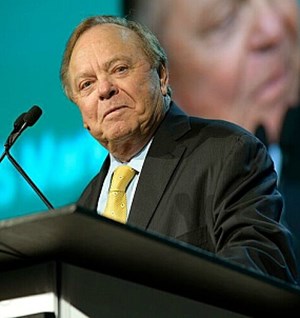U.S. shale pioneer “optimistic” despite declining production forecasts in prolific basins
(Bloomberg) – The first thing that greets visitors entering the headquarters of Harold Hamm’s Continental Resources Inc. is a 9-foot-long statue of a snarling bull named Boe.
Boe — short for barrels of oil equivalent — is an apt symbol for a veteran wildcatter who’s still betting big on more crude production in the U.S. Hamm is a shale pioneer, the first to figure out how to drill miles-long wells sideways to unleash oil from North Dakota’s Bakken shale region. At the time, it was the biggest U.S. oil find since Alaska’s Prudhoe Bay in 1968.
Today, Continental, which he and his family control, is the biggest oil producer in North Dakota and Oklahoma. Continental is also drilling wells in Wyoming and in the prolific Permian basin of West Texas and New Mexico.
“The future is bright,” Hamm, 77, said during an interview with Bloomberg News this month in his Oklahoma City office. “I look at it as an industry that is exciting, a lot of adventure, has a lot of potential for making great wealth.”
His optimism belies forecasts for the U.S. shale sector, which is showing signs of reaching middle age. Experts predict output will peak by the end of this decade. The Bakken has already lost its luster, with output trailing pre-Covid levels. Even in the Permian, the world’s busiest shale basin, production is expected to max out by 2030 and gradually trail off from there.
The current shale slowdown, combined with production cuts from the OPEC+ alliance, is expected to tip the world’s oil market into a deficit by the end of the year. And while that’s likely to support prices and please producers, it suggests the dynamism and growth in the U.S. industry as espoused by Hamm could become a thing of the past.
Hamm quibbles with the estimates, saying the Permian may not reach its high-water mark until 2035 and will see another 25% pop in production first.
“We’ve certainly seen some great days in shale,” he said. “But have we got a long way to go? Yeah.”
He spoke before the release of his new book, “Game Changer,” which goes on sale Tuesday. In it, Hamm pushes for a change in energy policy in Washington that would help boost oil and gas production. Hamm, the youngest of 13 children born to Oklahoma sharecroppers, also hopes the book will rally enthusiasm for the industry.
“Part of the purpose of this book is to encourage the next barefooted country boy to imagine that he could do something equally as good,” he said.
Though Continental is a major U.S. oil producer, Hamm still proudly calls himself a wildcatter — something of a rarity in an industry that’s largely become averse to risk. Continental is one of the few companies drilling in southern Oklahoma, a region not known for crude-rich shale deposits. Oil prices near $80 a barrel mean that for Hamm, it’s a bet worth taking.
“It’s a lot of fun,” Hamm said. “There is a thrill to it. Like finding ancient wealth.”
After runaway production triggered an oil-price crash about a decade ago, shale drillers have been under pressure to limit spending and return cash to shareholders. Hamm’s solution: Take Continental private. That process was completed late last year.
Still, Hamm says he’s proud of U.S. producers’ newfound discipline. He’s even learned to appreciate OPEC — once a thorn in shale’s side — for helping to balance the global oil market.
“You have a concentrated amount of production, particularly with the Saudis, and for them to act like a throttle, that’s pretty good,” Hamm said. “It prevents waste and oversupply and also saves some supply for increased demand without decimating the market.”
Continental’s production growth this year will be about 5%, Hamm said, in line with large publicly traded drillers. He expects similar growth next year.
As far as acquisitions go, Hamm is primarily looking at deals to expand in basins where Continental is already operating. But a trip with Hamm down to the basement of his 19-story office building suggests he’s not ruling out going farther afield.
All over the basement lobby, walls are newly installed murals depicting the four U.S. shale basins where Continental operates. Ask if that means he won’t be entering any more basins, Hamm looks at a nearby hallway with a blank, white wall and smiles. As far as he’s concerned, the heyday of searching for oil in unexplored fields is far from over.
“Forty years ago, prior to shale coming about, and horizontal drilling, finding the next hidden producing field was tremendous,” he said. “But does it still go on? Absolutely.”



